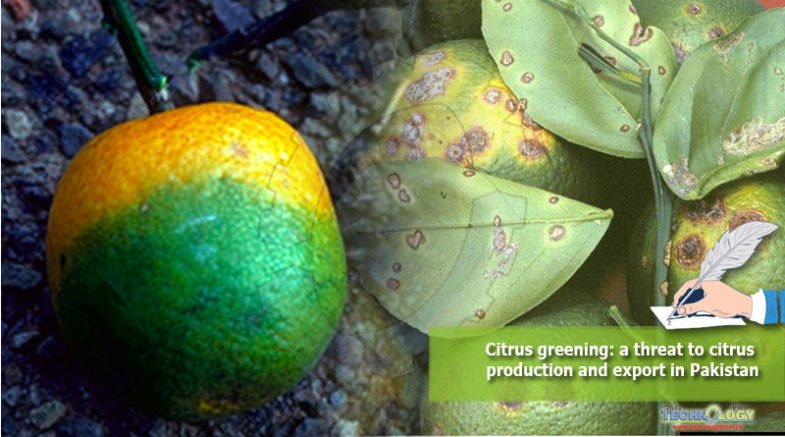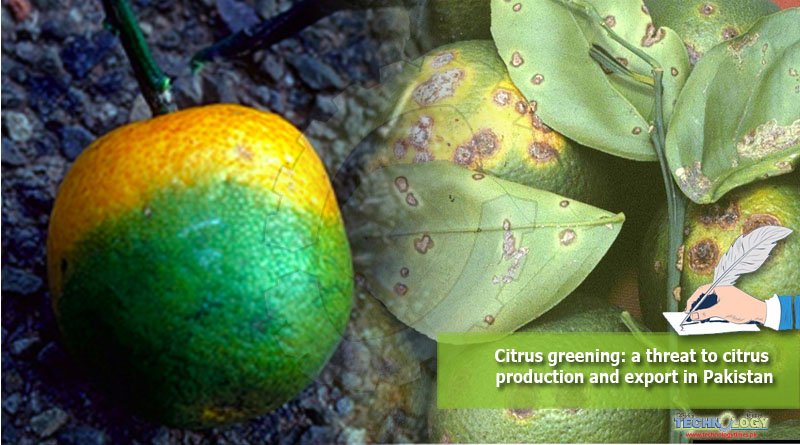Citrus greening became a headache to citrus growers and exporters.In the past few decades, Pakistan’s Citrus industry was badly affected by Citrus Canker which is a bacterial disease.

Citrus being a major fruit crop of Pakistan has a big share in exports of horticultural produce. The annual production of citrus in Pakistan was about 2.5 Million Tons in 2018.
Yield losses about 22% in Kinnow, 25–40% in sweet orange, 15% in grapefruit, 10% in sweet lime, and 2% lemon are reported. A big share of export quality fruit rejected annually due to the presence of signs of citrus greening disease on fruit.
At this time there is a need to control this disease by our growers to a reasonable level. There are also many diseases in the citrus crop which badly affect the fruit quality and its aesthetic look which made it unacceptable in the local and international markets.
Huanglongbing (HLB) considered as a bacterial disease assumed to be Originate from China in 1890 as “Yellow shoot disease”. The disease has symptoms on all over the plants and can be detected from leaves, shoot, chemical properties and fruits.
This disease is spread by bacteria and the causal organism is gram- negative bacteria genus Candidatus liberibacter (CL). Symptoms of this disease can be caused by CL asiaticus (CLas) CL Americanus (CLam), CL africanus (CLaf).
The Asiatic form is prevalent in Pakistan, which is a threat for the citrus industry of Pakistan. The Asian and the American species can be transmitted by the psyllid (Diaphorina citri) Kuwayama commonly called Asian citrus psyllid and the African species by the insect Trioza erytreae .
HLB CLaf is heat sensitive and affects the plants under medium temperature and can’t survive under high temperature and the other CLam and CLaf are heat tolerant and can survive under high temperature.
Citrus Greening is one of such kind of diseases which are threat to our citrus industry mainly exports. Citrus greening which is also called (HLB) Huang Long Bing presently affected the World’s citrus industry by affecting the cosmetic look of fruit in addition to juice content and flavor of fruit.
HLB was first reported from China at the end of 19th century as “Yellow shoot disease”. In America first reported in 2004 in the state of Sao Paulo. In Africa the disease was first reported in1937. This diseased leads to a great loss in yield of citrus in different citrus growing states of worlds like Florida and Sao Paulo.
At present there are more than 50 countries in Asia, Africa and America. Citrus export of Pakistan devastatingly affected due to this disease outbreak.
Symptoms
Symptoms of citrus greening appear slowly but can be observe through many parts of the plant like leaves, shoot, juice contents, fruits and chemical properties of fruit. The symptoms of citrus greening are described below.
Leaves
The symptoms of this disease appear like zinc deficiency. Commonly observed in the warm season of the year. The main symptoms are mottling and chlorosis. Starch contents are affected in leaves. Amount of Proline and amino acids amount increase in leaves.
Trees
The disease is known as decline in Taiwan, dieback in India, leaf mottle in Philippines, and yellow branch, blotchy mottle or greening in South Africa. Symptoms appear on plant like open growth, stunted growth, yellowing of leaves, sparse foliage and twig dieback. Reduced life.
Fruit
Size of the fruit reduced, small in diameter, asymmetric, contain black and brownish small seed some time aborted. Premature fruit drop cause to reduce yield by 30-50%.
Control and management
To control any disease in any crop the first and prior step is management. Through proper management we can control this disease at beginning stage.
As this disease is spread through insect the most important thing is to control vector to avoid the spread of infection. The management of HLB includes proper nutrition and foliar application of readily absorbable nutrient, irrigation management and through pH adjustment to recommended level.
As this is a bacterial disease so it is very much difficult to control this disease. The most effective and recommended control is removal of affected plant and replanting of disease free and resistant plants.
Use of screen houses to reduce the vector movement and also to reduce the insecticidal residues. Methomyl or melathion spray on tree at 10-12-day interval to control vector. Tamarixia radiata also prove affective to control aphid. Different insecticides like Carbofuran and Dimathoate show the best result to control psylla.
To control the citrus greening mother plant should be checked on regular basis and kept in isolation to avoid infestation through insects (psylla) Hot water treatment of grafting wood at 48-50°C for few minutes. Trees with 50-70% infestation should be eradicated. Tetracycline hydrochloride proves beneficial in controlling the symptoms on leaves.
This article is jointly written by By Bilal Akram, Dr. Mujahid Ali and Dr. Zahoor Hussain (Horticulture, UOS)
